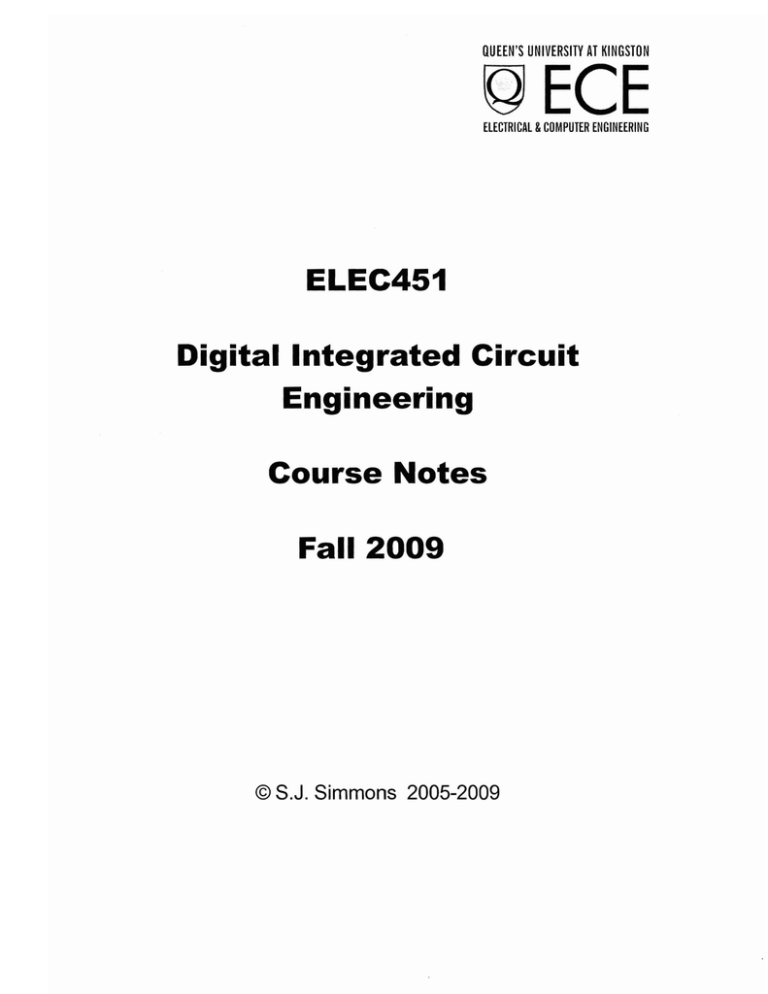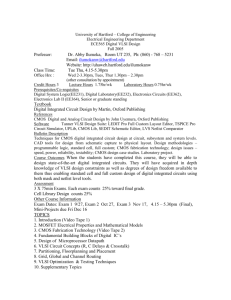here
advertisement

QUEEN'S UNIVERSITY AT KINGSTON \QECE ELECTRICAL &COMPUTER ENGINEERING ELEC451 Digital Integrated Circuit Engineering Course Notes Fall 2009 © S.J. Simmons 2005-2009 ii Introduction 1 MOS Transistors 4 MOS Current versus Voltage Characteristics 9 CMOS Processing 11 The CMOS N-Well Process 17 Other Process Issues 23 Design Rules 26 The CMOS Inverter 30 CMOS Logic Implementation 34 Efficient CMOS Logic Layout 37 Muliplexer-Based Logic Implementation 39 Alternative Logic Implementations 43 CMOS Dynamic Behaviour 47 Sloped Signals and CMOS Dynamic Behaviour 49 Switched-R Delay Modelling 52 CMOS Power Dissipation 54 CMOS Transistor Parasitic Capacitances 57 Characterizing Logic Gate Delays 60 Buffering to Reduce Total Propagation Delay 64 Latches and Flip-Flops for Clocked Systems 66 Dynamic Logic 70 Clocked Systems Concepts 74 Static vs. Dynamic Clocked Systems 77 ii iii Clock Overlap Issues 81 Interconnect Delay Contributions 84 Clock Distribution 87 Chip Input/Output Circuits and Connections 90 Memory Arrays 95 Static RAM (SRAM) 100 Dynamic RAM (DRAM) 104 Erasable Progra.mmable ROM 108 Programmable Logic 113 Process Technology Scaling Issues 120 Low Power Methods 124 Design/Implementation Alternatives 131 Design Flow 138 The Present, and Future Trends 146 AfterWord 150 iii Introduction In ELEC451 we will look at the engineering of digital integrated circuits from the bottom up. We begin the course by examining the physical process by which CMOS transistors are fabricated on a silicon wafer, and end the course with the design processes used to design multi­ million-transistor chips. By the end of the course, you should have an appreciation for and basic understanding of: ~ The scale of modern day digital integrated circuits. ~ The speed at which the circuits operate, and how to model their switching behaviour. ~ The different circuit styles that can be employed, and their relative advantages and disadvantages. ~ The dominant role played by circuit pa.rasitics in circuit/chip performance. ~ How weak on-chip signals are interfaced to drive circuit board lines in the external world. ~ How ongoing technological advances affect circuit speed, density, and power consumption. ~ The design and characteristics of different volatile and non-volatile memory types. ~ The design of programmable logic arrays. ~ The different chip implementation styles available to the designer. ~ ~ The design flow from circuit concept to final chip implementation. The Semiconductor Industry Association (an affiliation of interested companies and organizations) periodically issues a "technology roadmap" that makes predictions about where integrated circuit engineering is headed. Figure 1 and Table 1 on page 2 illustrate trends in process feature size, number of transistors per chip, and microprocessor chip clock rate. Note how regular periodic shrinks in feature sizes have been allowing an exponential rate of increase in the number of transistors per chip, and in the achievable clock speeds, without power consumption exploding (and this trend is predicted to continue in the near future). We will see later in the course why these gains have been possible. Page 3 is a die photomicrograph of a Pentium™ II processor (courtesy Intel Corporation). This photo illustrates the enormous level of circuit integration that was possible even several years ago, and gives a useful encapsulation of what we wish to study in ELEC451. We will explore the processes and design considerations that go into the creation of such a device, and the limits on its performance. · \ . ~ , DEEP-SUBMICRON DESIGN 2001 0.15 IV ·2003 0.13" . 1.2-1.5 1.2-1.5 40M 76M 1.7G 4.2.9G 385 430 1,500 2,100 1,400 1,600 110 130 , . Pentium™ 3




